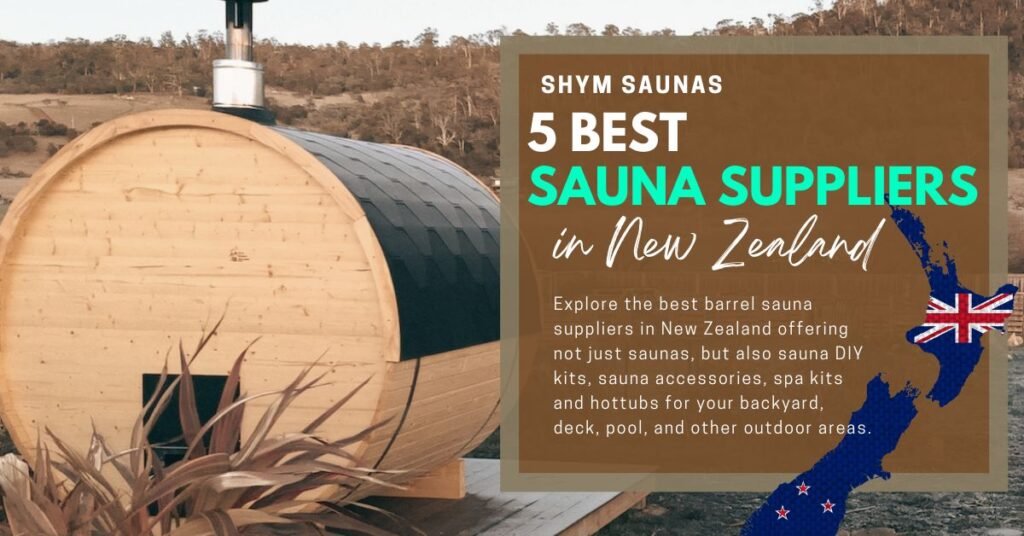What’s the best sauna design that will fit well in your small space? Are you maximizing your space for a sauna leisure? Here are the best small sauna ideas for you!
Saunas are an excellent addition to any home, providing relaxation, health benefits, and a luxurious touch.
But what if you think you don’t have the space for one? Don’t worry—small saunas are versatile and can fit in various areas, both indoors and outdoors.
Whether you’re considering a walk-in closet conversion, a compact outdoor unit, or a bathroom sauna, this guide will inspire you to create your perfect small sauna. Let’s dive into the possibilities!
Key Takeaways:
- Find different locations for placing a small sauna, including indoor and outdoor options.
- Learn about prefabricated vs. custom small sauna designs and their space-saving benefits.
- Explore materials and accessories that can enhance your sauna experience, like wood types, tiles, and lighting.
- Get cost-effective tips for setting up and maintaining a small sauna.
- Understand the importance of proper design for maximising the health benefits of sauna.
Whether you’re considering a walk-in closet conversion, a compact outdoor unit, or a bathroom sauna, Shym Saunas’ prefabricated barrel saunas make it easy to create your perfect small sauna.
Location Ideas for Small Saunas
Finding the right spot for your small sauna is crucial. It’s all about maximising the space you already have. Here are a few ideas:
1. Indoor Small Sauna Setups
Walk-in Closet Transformation
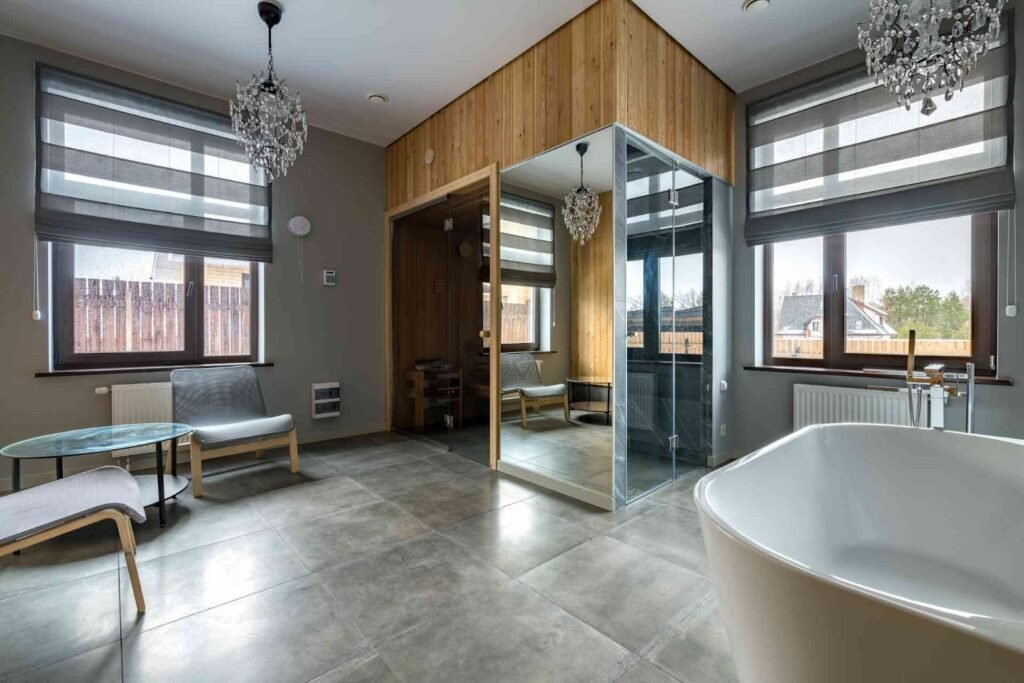
If you have a walk-in closet, you have the perfect opportunity for a small sauna setup. According to Straughan of KAA Design, a space as small as 5’ x 5’ (152.4 x 152.4 cm) is enough to create a cosy sauna. This option allows you to maintain privacy and create a secluded space for relaxation without taking up additional square footage.
Small Bathroom Sauna (Integration Tips)
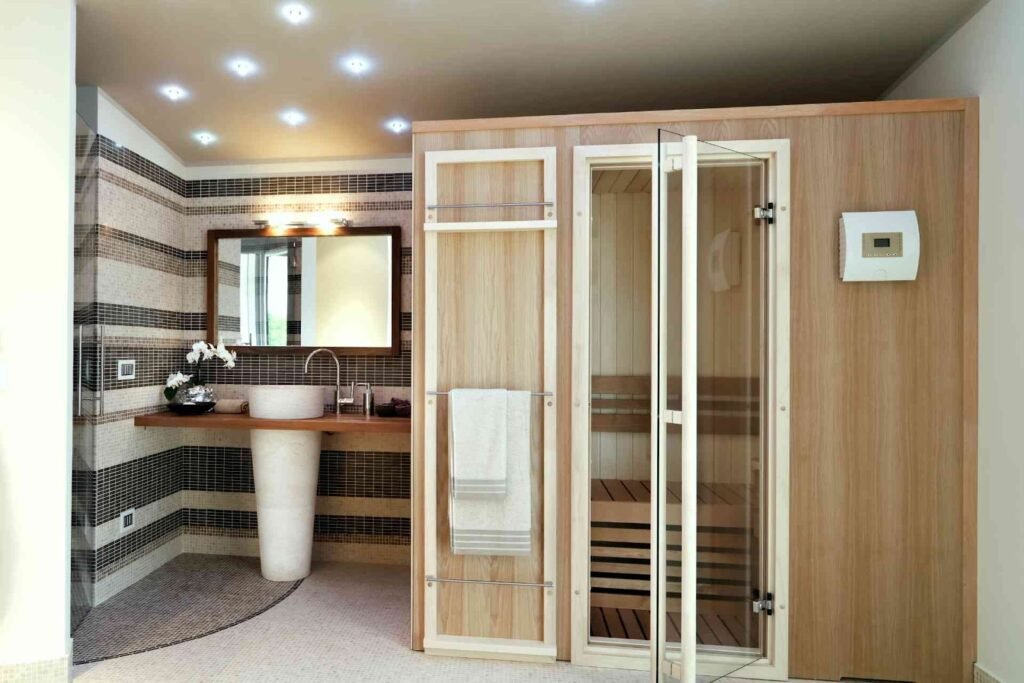
A bathroom is one of the most popular spots for a sauna. You can convert a section of your bathroom, such as the shower or tub area, into a small sauna. Using consistent flooring and materials can create a seamless look, making the sauna feel like a natural extension of your space. This setup is perfect for quick, convenient access, especially for post-sauna showers.
Garage Space Optimisation

Do you have some extra room in your garage? Turning a corner of your garage into a sauna can be a clever solution. It’s an excellent way to use up the space that might be occupied by stored items. Clean up the area, and you’ll have a cosy, private spot for your sauna. However, ensure proper ventilation and avoid locating your sauna in a garage where you park vehicles or store chemicals to prevent exposure to harmful fumes.
2. Outdoor Small Sauna Solutions
Backyard Oasis with a Prefab Sauna
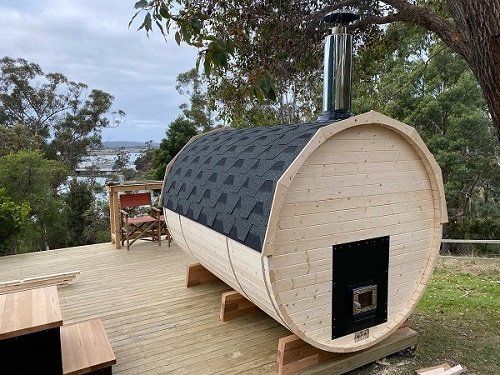
If you prefer an outdoor sauna experience, placing a prefab unit in your backyard is a great option. You can choose a compact model that fits perfectly into a small corner, allowing you to create a garden retreat. With this setup, ventilation isn’t a problem, and you can enjoy nature while you relax.
Patio Installation Options
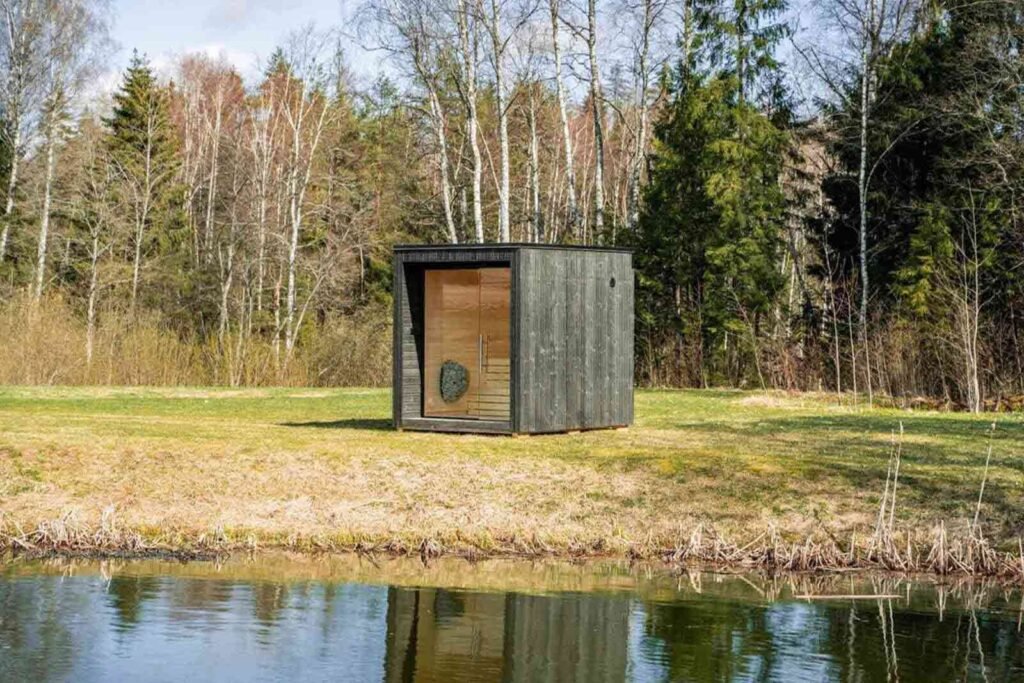
No backyard? No problem. A small sauna can be installed on your patio or deck. Prefabricated models are ideal for these spaces, offering flexibility without requiring major construction work. Add a lounge chair or two, and you have an instant relaxation zone.
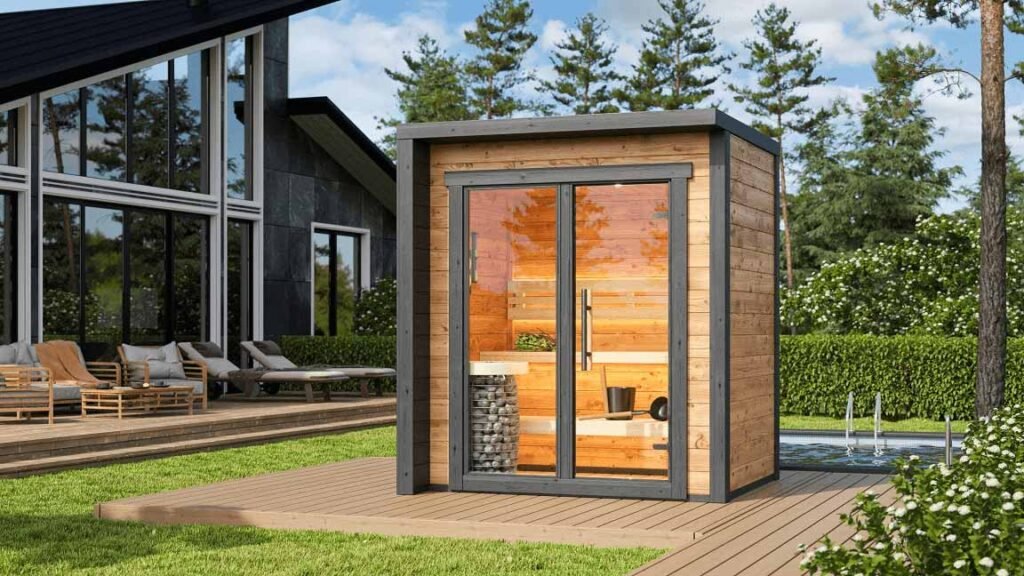
Compact Garden Sauna
<image>
A garden sauna can be a unique addition to your outdoor space. By customising a small, freestanding sauna, you can add a visually appealing structure that enhances your garden’s aesthetic while offering a functional spot for relaxation.
Types of Small Saunas
Small saunas come in various styles and setups. Let’s explore some options to help you choose the right one.
Prefabricated Sauna Units
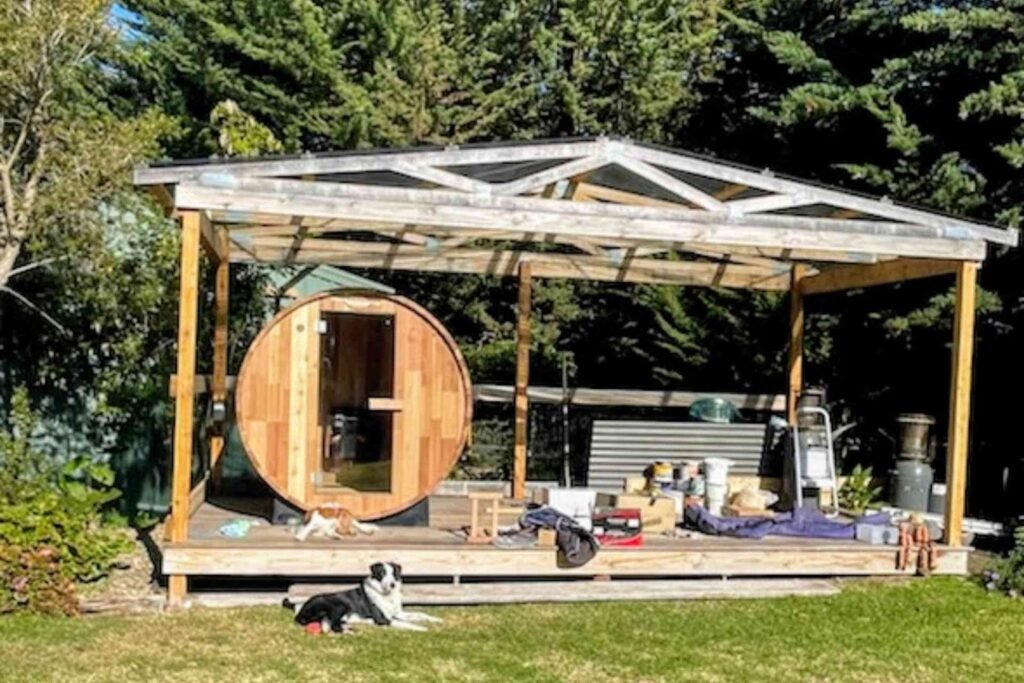
Prefabricated saunas are popular due to their convenience and flexibility. These units come in a variety of sizes, suitable for one to five persons, making them a perfect fit for small spaces. They typically range from $1,500 to $10,000, depending on the features and materials.
Custom Small Sauna Designs
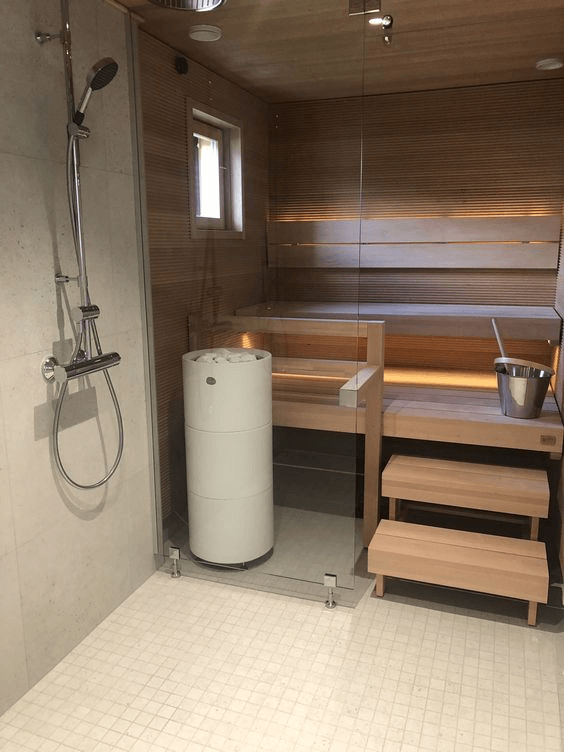
Source: Trumpkin’s
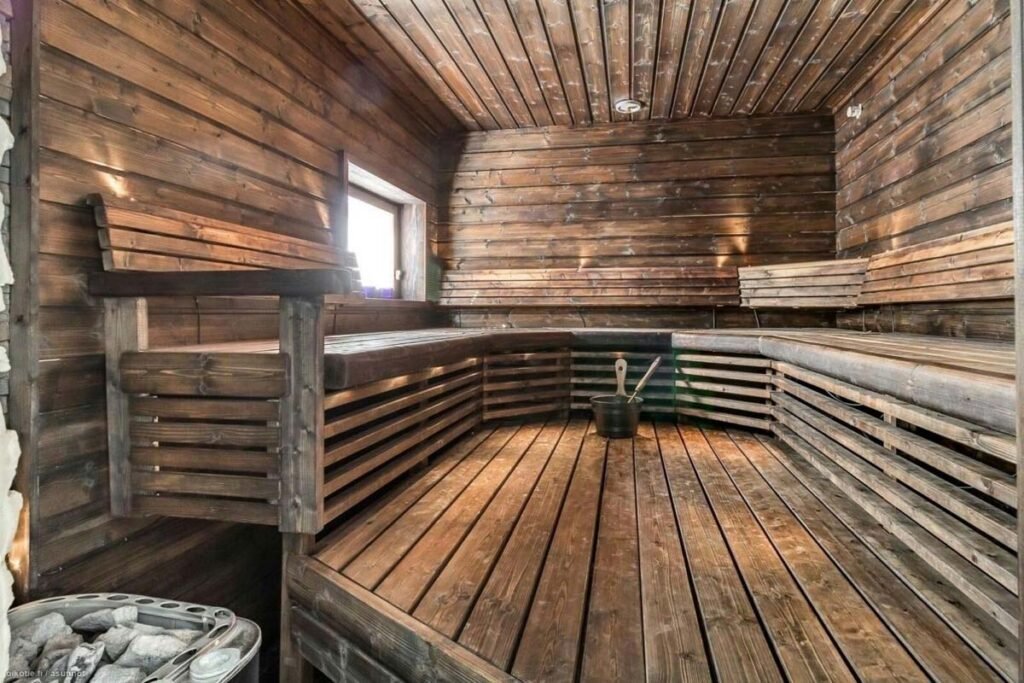
Custom saunas are the way to go if you prefer a more personalised touch. You can convert small spaces, like showers or bathtubs, into saunas, which offers a unique design element tailored to your space. This option allows you to choose your materials, such as glass doors, to visually expand the area.
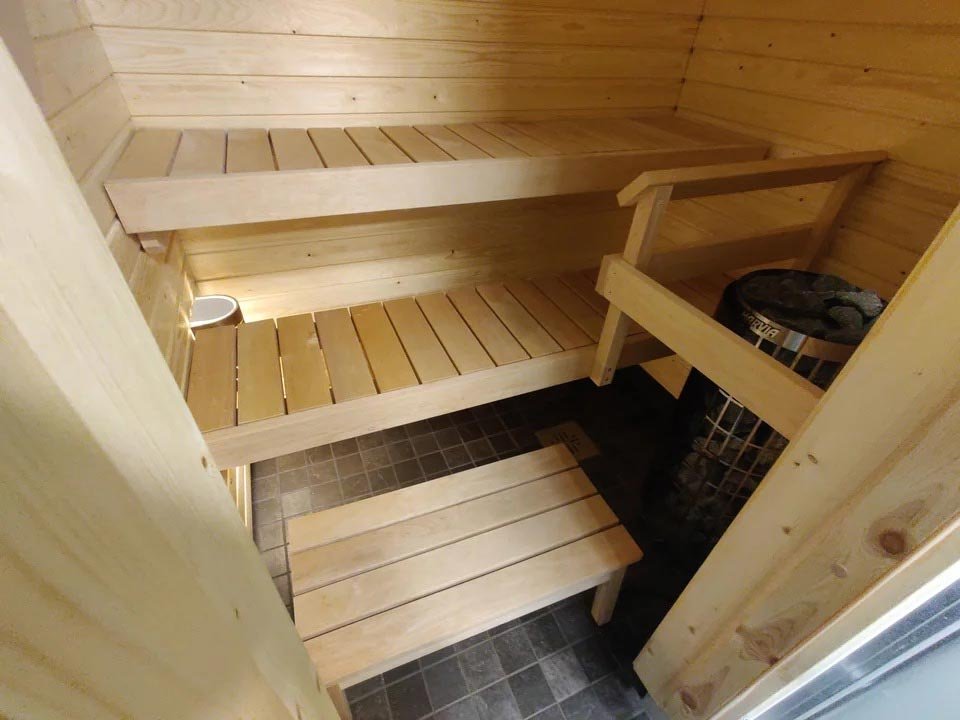
Small Sauna Design for Maximum Impact
While space may be limited, thoughtful design can significantly enhance your small sauna experience. Here are key considerations:
Optimising Heat Flow and Cavity Design
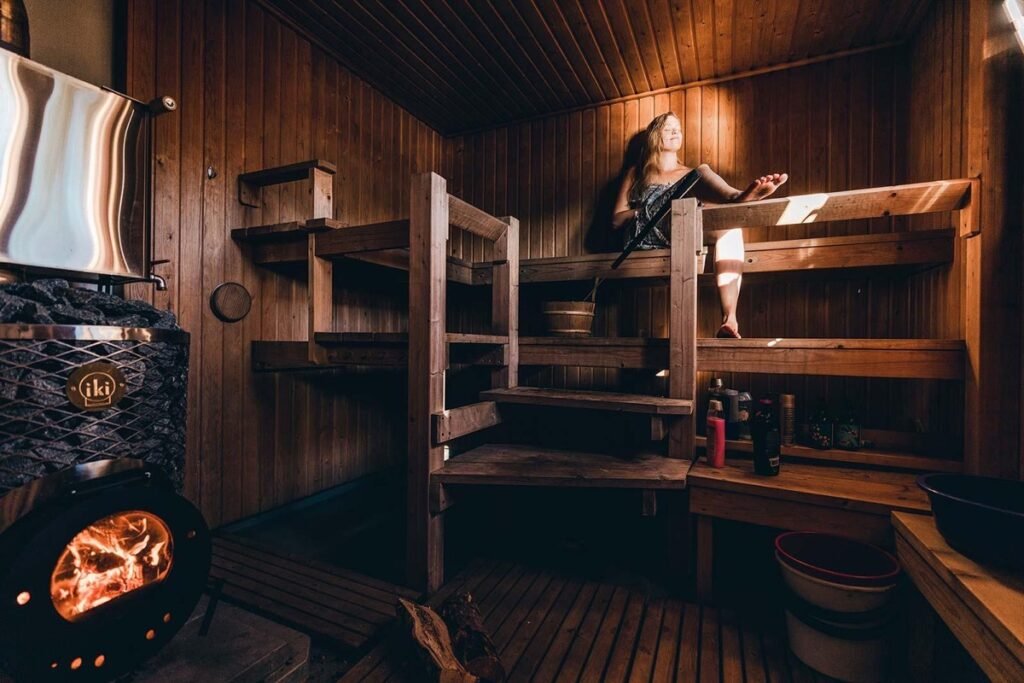
A standard 8’x9’x9’ sauna designed for four people features elevated benches that keep bathers away from the direct heat of the heater, positioning them comfortably within the löyly cavity.
Even in a small sauna, creating an effective heat environment is crucial. The “löyly cavity” is the area where bathers are enveloped in gentle, descending heat and steam. To achieve this, carefully position the heater on the wall opposite the benches. This placement creates a convective loop, carrying heat and steam across the ceiling and down towards the bathers.
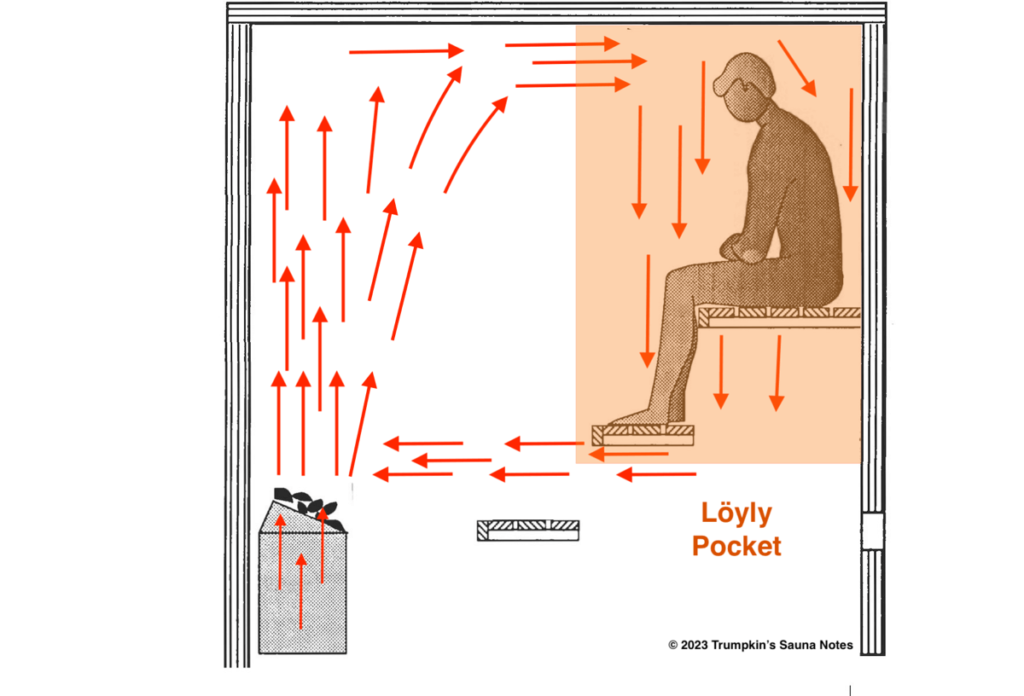
Proper airflow through the benches and skirts ensures that the heat and steam evenly surround you, providing a fully immersive experience.
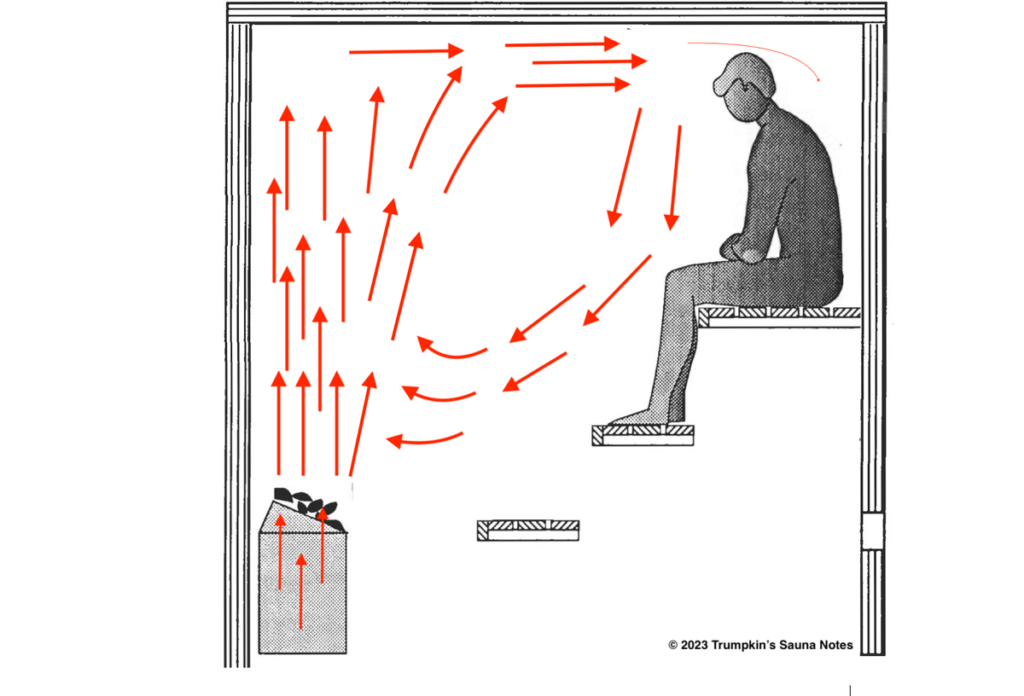
Inadequate air gaps can lead to uneven heat and steam distribution, causing cold feet and possibly a chilly back.
Visualising airflow is also important. Imagine hot air rising from the heater, traveling across the ceiling, and then descending on the opposite side. To maintain this flow, keep the space between the heater and benches clear of obstructions that could disrupt circulation and cause uneven heating. Additionally, maximising the “heat cavity” above the door traps the hottest air, and having a higher ceiling—even in a small sauna—minimises heat loss when the door opens, maintaining a consistent temperature and reducing energy waste.
Ensuring Proper Ventilation in Small Saunas
Proper ventilation is essential for a comfortable and healthy sauna experience, even in small spaces. Despite being called “dry saunas,” traditional saunas produce significant moisture when water is thrown on the stones, combined with perspiration from bathers. This creates humidity that must be managed through adequate ventilation.
To achieve proper airflow, you have two main options:
Passive Vents
Positioning vents strategically can create natural airflow, bringing in fresh air while expelling stale, humid air.
Here’s an e an example diagram from Harvia, featuring a wood-burning stove:
Mechanical Ventilation
For more efficient air exchange, consider a small-duct mechanical system with an intake near the heater and an exhaust positioned low on the opposite wall.
Ensuring fresh air circulation regulates temperature, prevents mold growth, and creates a more enjoyable sauna experience.
Key Elements of Mechanical Ventilation:
- Fresh Air Inlet: Install the fresh air inlet around 500 mm above the stove to maximise airflow circulation.
- Exhaust Air Outlet: Position the exhaust outlet near the floor, such as beneath the benches. This setup helps remove humid air from the lower part of the sauna, ensuring a consistent temperature.
- Exhaust Fan Placement: For optimal results, an exhaust fan can be installed on the ceiling, similar to a bathroom setup. This is particularly effective in preventing mold and controlling humidity levels after sauna use.
In some setups, placing the exhaust vent below the benches can be beneficial for maximising efficiency. However, this positioning may make the ventless accessible, so it’s important to weigh the pros and cons based on your sauna’s layout and usage.
Additional Considerations:
- Air Volume Per Person: Ensure your sauna has at least 3 cubic meters of volume per person. This volume makes passive ventilation more effective.
- System Configuration: Research by the Finnish technical research institute VTT suggests placing the fresh air supply above the stove (but not in the ceiling) and positioning the return vent below the “feet bench” for optimal efficiency. An exhaust vent in the ceiling is also recommended for removing hot, damp air after use.
More on Sauna Ventilation Systems here.
Infrared Saunas vs. Traditional Heat Saunas
Choosing the right heating method is also crucial for small saunas. Infrared saunas heat the body directly, making them ideal for small spaces since they don’t require extensive ventilation. They offer various health benefits, such as deep tissue detoxification and energy efficiency.
On the other hand, traditional saunas provide the classic sauna experience using electric or wood-burning heaters. While they might require more space for proper ventilation, they create an immersive heat environment and the option for wet or dry steam, enhancing the overall sauna atmosphere.
Want to know more about the difference between Infrared Saunas and Traditional Finnish Saunas? Check out our guide.
What is the REAL Finnish Sauna Culture that you’re missing out? Read our fun and comprehensive guide on Finnish Sauna Culture.
Best Materials for Small Saunas
Selecting the right materials enhances the longevity and aesthetic of your sauna. Let’s look at some options.
Wood Choices
- Cedar, Pine, and Hemlock: Pros and Cons: Cedar is a popular choice for saunas because it’s durable, resistant to moisture, and has a pleasant aroma. However, cedar can be overly fragrant for some and may even cause respiratory or skin irritation. Consider the potential drawbacks of cedar before making your selection. Pine and hemlock are also great alternatives, providing a rustic look while being budget-friendly.
- Alternatives like Eucalyptus for Scent and Durability: Eucalyptus wood not only adds a unique scent but is also durable, making it a perfect option for those seeking an aromatic experience.
- Softwoods are generally preferred for their ability to absorb noise and create a more tranquil environment.
For more sauna wood choices, check out our guide: Sauna Wood Types: What Wood to Use in a Sauna?
Incorporating Tiles or Stones
When to Use Mosaic Tiles
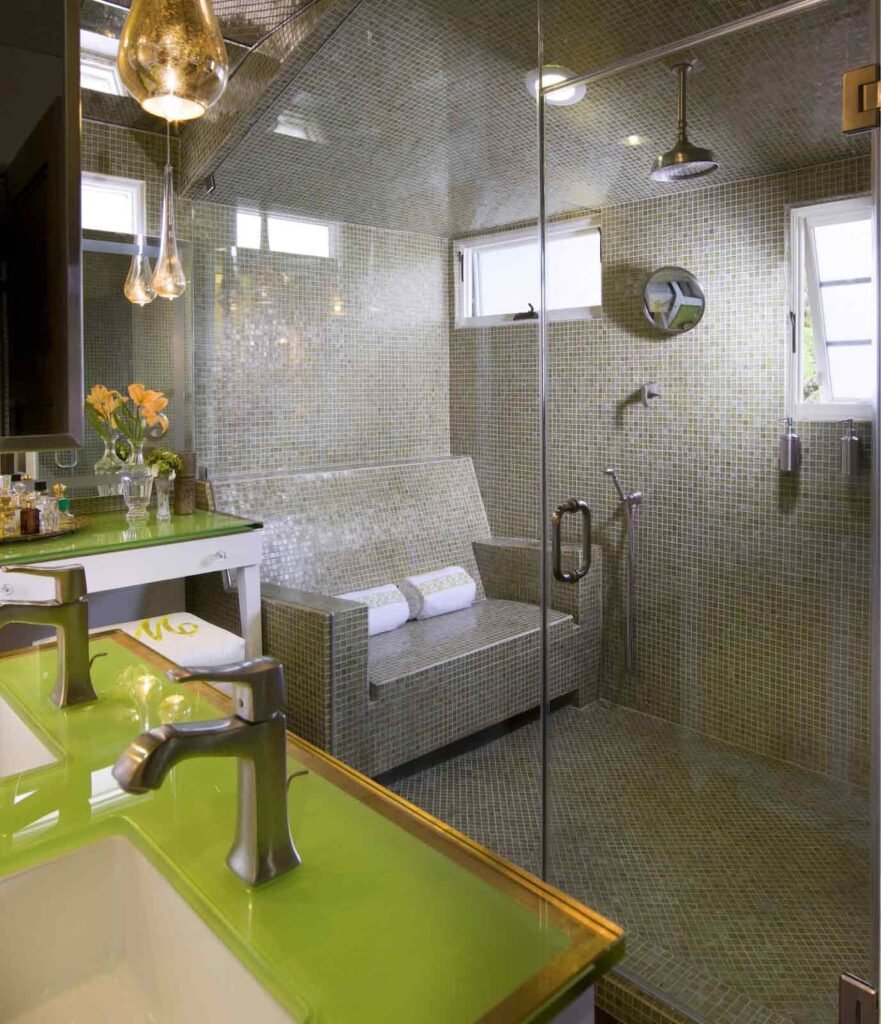
If you’re integrating a steam element or creating a wet sauna, mosaic tiles work well on curved surfaces like benches and walls. They are excellent for moisture protection and add a stylish touch.
Adding Volcanic Stones for Heat Retention
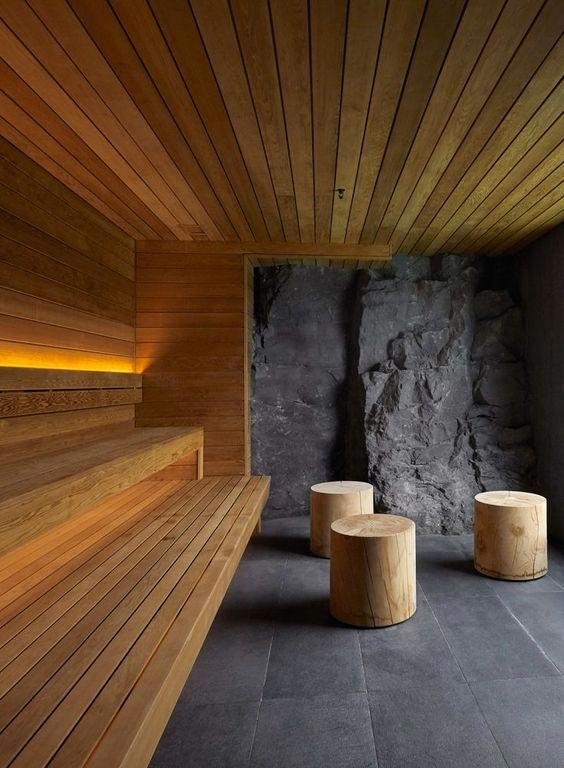
Volcanic stones, like lava rocks, can be added to enhance heat retention. They create a natural aesthetic and help maintain high temperatures for longer periods.
Small Sauna Benches: Making the Most of Limited Space
In a small sauna, optimising bench design is crucial to maximise both comfort and functionality. Here’s how to make the most of your limited space:
Bench Height is Key
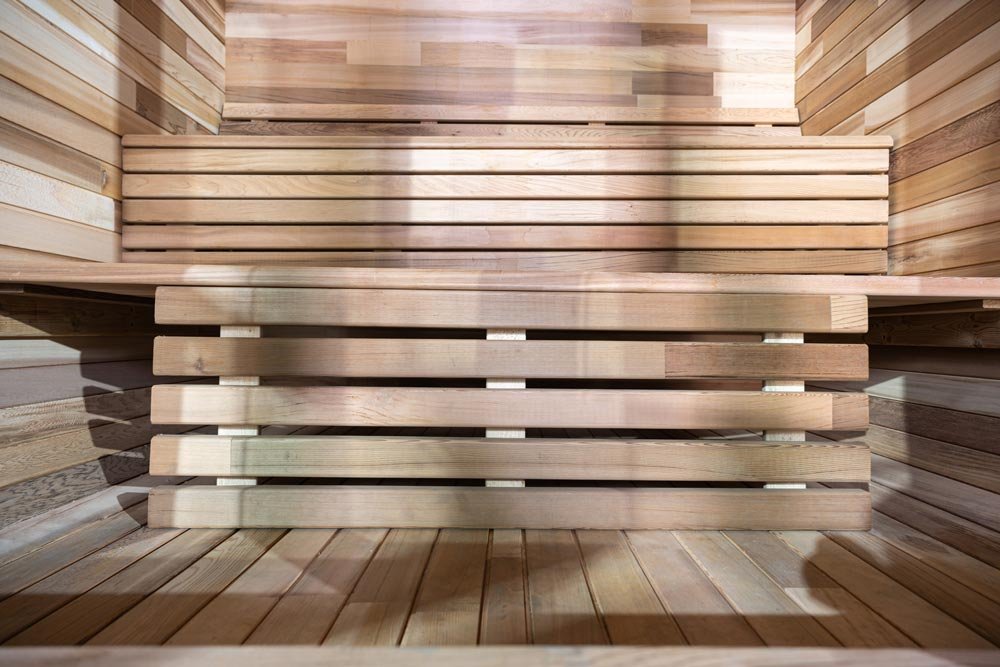
Even in a small sauna, prioritise bench height. As the popular sauna builder’s guide, Trumpkin’s Notes, emphasises, getting your feet above the “cold zone” (the lower third of the sauna) is vital for an even and comfortable experience. Aim for a foot bench that’s at least 85cm (34″) high. This might require a raised platform or a three-tiered bench system, but the improvement in heat distribution and steam circulation will be worth it.
Space-Saving Bench Designs
- Compact benches: Opt for benches with minimal overhangs or skirts to maximise floor space. Consider benches that fold up or slide in when not in use to create extra room.
- Corner benches: L-shaped benches utilise corner space efficiently, providing more seating in a smaller footprint.
- Vertical space: If floor space is limited, consider adding a third, higher bench level. This allows more people to enjoy the sauna while also improving heat distribution, as described in Trumpkin’s Notes.
Material Considerations for Benches
- Softwoods: Choose softwoods like cedar, pine, or hemlock for benches. These woods, as highlighted in Trumpkin’s Notes, have excellent hygroscopic properties (absorbing and releasing moisture), which helps regulate humidity and create a more comfortable sauna.
- Heat-resistant wood: Ensure the wood can withstand high temperatures without releasing excessive resin or becoming uncomfortably hot to the touch.
- Smooth finish: Sand benches thoroughly and round any sharp edges to prevent splinters and ensure a comfortable seating experience.
Small Sauna Decor and Accessories
Once you’ve set up your sauna, it’s time to personalise it with decor and accessories that enhance the experience.
Lighting Options: Lighting plays a crucial role in creating the right ambiance. Heat-resistant, dimmable lights are perfect for adding a warm, relaxing glow. You can also explore chromotherapy lighting options for additional wellness benefits.
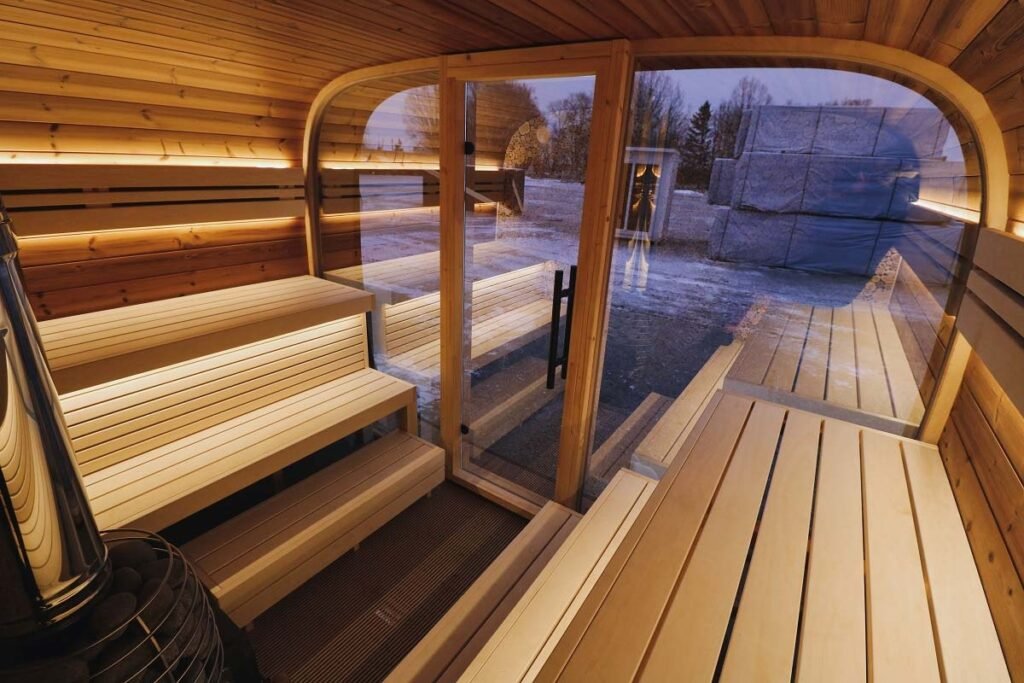
- Adding a Sound System: Incorporating a sound system into your sauna elevates the experience. Play calming music or guided meditations to enhance your relaxation. Bluetooth speakers are easy to install and can be controlled from outside the sauna, ensuring your tech remains safe from moisture.
- Enhancing with Salt Walls and Crystals: For an added touch, consider incorporating a Himalayan salt wall or amethyst crystals into your sauna design. These elements not only provide visual appeal but also contribute to respiratory and skin health.
Hygiene in Your Small Sauna
While enjoying the relaxation and therapeutic benefits of your small sauna, it’s essential to prioritise hygiene. A clean sauna is not only more pleasant but also contributes to a healthier experience. Here’s how to maintain a hygienic environment in your small sauna:
Heat for Hygiene
As Trumpkin’s Notes emphasize, heat is your ally in maintaining a hygienic sauna. Bacteria and mold thrive in temperatures between 4°C and 70°C (40-160°F). After each sauna session, ensure your sauna reaches and maintains a temperature of at least 65°C (149°F) for 15-20 minutes, especially at the bench level. This “heat treatment” effectively eliminates bacteria and prevents mold growth, ensuring a sanitary environment for your next sauna session.
Conclusion
Creating a small sauna is all about maximising your space while ensuring comfort and efficiency. Whether you choose an indoor setup like a walk-in closet or an outdoor option on a patio, the possibilities are diverse. By selecting the right type—prefab or custom—and optimising airflow, ventilation, and materials, you can build a functional and relaxing retreat in your home.
Thoughtful planning allows you to incorporate features like lighting, sound systems, or salt walls to elevate your experience. With the right approach, your small sauna can become a perfect wellness escape, providing luxury and health benefits in even the cosiest spaces.


